Содержание
- 2. Google, books Part 2. Section 2
- 3. Why do we need to learn about the methods of teaching English which were popular in
- 4. The concerns that have prompted modern method innovations were similar to those that have always been
- 5. Many current issues of language teaching are not particularly new !!! Today’s controversies reflect contemporary responses
- 6. Particular methods differ in the way they address key issues. These issues are as follows:
- 7. What should the goals of the language teaching be? Should a language course try to teach
- 8. 5. What should the role of the native language be? 6. What processes do learners use
- 9. We integrate or take into account past approaches rather than sweep them away.
- 10. The early applied linguists such as Henry Sweet (1845-1912), Otto Jespersen (1860-1943), and Harold Palmer (1877-1949)
- 11. 1850s – 1950s: Grammar Translation method
- 12. Learning Theory: Deductive learning is essential: First, the teacher gives rules explicitly then the rules are
- 13. Teachers' Role: Teacher is the strict authority. Classes are teacher-centred. Students' Role: Students are the passive
- 14. Vocabulary Teaching: The most common vocabulary teaching technique is “the memorisation of long lists of vocabulary
- 15. Grammar Teaching: The teaching of grammar is deductive. The teacher introduces the rules explicitly and wants
- 16. Materials: Texts from the target language literature are used. The teacher may either write the text
- 17. Goals and Objectives: Among the goals are to teach translation, to read and understand literary texts
- 18. Techniques 1. Translation of a Literary Passage: Students translate a passage from the target language into
- 19. First, they answer information questions whose answers they can find in the passage. Second, they answer
- 20. 3. Antonyms / Synonyms: Students are given one set of words and are asked to find
- 21. 6. Memorisation: Students are given lists of target language vocabulary words and their native language equivalents
- 22. General overview: - grammar was taught as a set of rules (e.g. verb conjugations) after the
- 23. - written text was seen as the ‘real’ language, superior to the spoken version; - written
- 24. Which of the techniques and principles of GTM do we still use in the modern language
- 25. 1890s – now: Direct Method
- 26. Behaviourism: learning as habit formation The first coherent theory of learning was the behaviourist theory based
- 27. Learning Theory: Inductive learning is essential. There is a direct relation between form and meaning. L2
- 28. Teacher's Role: The teacher usually directs the interactions but he/she is not as dominant as in
- 29. Vocabulary Teaching: Pictures, realia, examples, sample sentences are used to teach vocabulary. The use of L1
- 30. Role of L1: L1 is not permitted. Evaluation: Sts' ability to use the language is tested.
- 31. Skills: Speaking, listening, reading and writing are important skills. Especially speaking and listening are emphasised. Vocabulary
- 32. General overview: - speaking and listening were the most important skills; - the medium of instruction
- 33. - vocabulary was learnt either incidentally, as part of the phrases being taught, or via lists
- 35. Francois Gouin. Learning a language the wrong way http://hubpages.com/hub/Language-Learning-Methods-Scams-lies-and
- 36. The Direct method was quite successful in private language schools, such as those of the Berlitz
- 37. 1. It was difficult to implement in public secondary school education. !!!
- 38. 2. It overemphasized and distorted the similarities between naturalistic first language learning and classroom foreign language
- 39. 3. It lacked a basis in applied linguistic theory, and for this reason it was often
- 40. Which of the techniques and activities suggested by the Direct Method do we use in the
- 41. Audio-lingual method + Structuralist view of language A ‘scientificised’ version of the direct method; the new
- 42. Learning Theory: Learning is based on the principles of Behaviourism. Habit Formation is essential. Rules are
- 43. There is a natural order of skills. 1. Listening, 2. Speaking, 3. Reading, 4. Writing. Language
- 44. Teacher’s Role: T is like an orchestra leader. S/he directs and controls the language behaviour of
- 45. Interactions: T-St, ST- ST. Interactions are mostly initiated by the teacher. Vocabulary Teaching: Meaning is taught
- 46. Role of L1: L1 is not allowed in the classroom. It may cause interference and bad
- 47. Skills: Listening and speaking are emphasised. There is a natural order of skills. Listening 2. Speaking
- 48. - vocabulary was seen as an adjunct to the structures; - speaking and listening were the
- 49. - automaticity of response was favoured; - the language laboratory epitomised the audio-lingual approach and was
- 50. Various kinds of drills Repetition. The student repeats an utterance aloud as soon as he has
- 51. 2. Infections. One word in an utterance appears in another form when repeated. I brought the
- 52. 3. Restatement. The students rephrases an utterance and addresses it to someone else, according to instructions.
- 53. 5. Integration. Two separate utterances are integrated into one. They must be honest. This is important.
- 54. 7. Restoration. The students is given the sequence of words that have been picked out from
- 55. 1960s –1980s (UK): Structural-situational method (PPP) This was a pragmatic (i.e. UK) version of audio-lingualism; the
- 56. this approach gave rise to the idea of PPP (presentation, practice, production), e.g. the Present Simple
- 57. it was assumed that what we taught during these three stages was what the students should
- 58. 1970s – 1980s: Humanistic approaches Silent Way, Total Physical Response, Suggestopedia etc.
- 59. Why humanistic?
- 60. Behaviourism: learning as habit formation Mentalism: thinking as rule-governed activity Cognitive code: learners as thinking beings
- 61. THE SILENT WAY (SW) (Caleb Gattegno) Learning Theory: Cognitive Psychology is the basis. Language learning is
- 62. Teachers' Role: The teacher is a technician or an engineer who facilitates learning. Only the learner
- 63. Students' Role: Students should make use of what they already know. They are responsible for their
- 64. Vocabulary Teaching: Vocabulary is taught by means of visual aids and word-charts. Vocabulary is always recycled
- 68. Role of L1: L1 can be used to give instructions when necessary. Meaning is made clear
- 69. Goals and Objectives: Students should be able to use the target language for self expression (to
- 70. Techniques: 1.Teaching pronunciation with "sound colour charts" 2. Cognitive coding with colour rods. 3. Peer correction
- 72. 6. Structured feedback: Students are invited to talk about the day's instruction (what they have learnt
- 73. Learning Theory: People use 5-10% of their mental capacity. In order to make better use of
- 74. Six principle theoretical components through which desuggestion and suggestion operate. 1). People remember best when the
- 75. 4). Varying intonation of the presented material helps to avoid boredom. T should present the material
- 76. 2. Teachers' Role: Teacher is the authority. Learners learn better if they get the information from
- 77. 6. Grammar Teaching: Grammar is taught explicitly but minimally. Explicit grammar rules are provided in L1.
- 78. 8. Goals and Objectives: Teachers hope to accelerate the process by which students learn to use
- 79. 10. Student's Feelings: A great deal of attention is given to students' feelings. Students should feel
- 80. Techniques: Classroom set up: dim lights, soft music, cushioned armchairs, and posters on the walls. Direct
- 81. Peripheral Learning: Posters, lists, charts, texts, paintings, and graphs are hung on the walls of the
- 82. Choose a New Identity: Students can be asked to write about their fictional new identity, new
- 83. . Primary Activation: Primary activation and secondary activation are the components of the active phase of
- 84. TOTAL PHYSICAL RESPONSE METHOD (TPR) Learning Theory: There are three hypotheses: A) Innate Bio-program: There exists
- 85. B) Brain Lateralisation: The brain has two main parts: left hemisphere, and right hemisphere, which have
- 86. Teachers' Role: Initially the teacher is the director of all student behaviour. In the later stages,
- 87. Vocabulary Teaching: Vocabulary is introduced through imperatives. Verb is the kernel. Other categories like adjective, adverb,
- 88. Role of L1: The method is introduced in the students' L1. After the introduction, rarely would
- 89. Student's Feelings: The teacher should not force the students to speak. Silent period must be taken
- 90. Techniques: A) Commands: Use of commands is the major technique. Commands are given to students to
- 91. Skills: Natural order of skills: 1. Listening (Very important during the silent period) 2. Speaking (teacher
- 92. Communicative language teaching
- 93. The first tranche of the communicative 'revolution' was based on the idea of grouping bits of
- 94. The basic principle of all communicative activities in the classroom, whether accuracy-based or fluency-based, was the
- 95. As an example of the accuracy-oriented information gap, we can have ‘communicative drills’ (e.g. students interview
- 96. TASK-BASED APPROACHES It is a methodological idea which attempts to get away from PPP altogether; students
- 97. An example would be ‘have the students in groups plan a recreational weekend in London for
- 98. The best General English textbook series using this approach is the 'Cutting Edge Series' by Peter
- 99. Lexical views of language As early as the 1970s, academic linguists noticed that the language was
- 100. Since then, notably through the writings of Michael Lewis in the early 1990s, the Lexical View
- 101. The Modern Integrated Language Teacher We use translation when it is quick and efficient to get
- 102. we use information gaps almost all the time, in accuracy as well as fluency work; we
- 104. Скачать презентацию


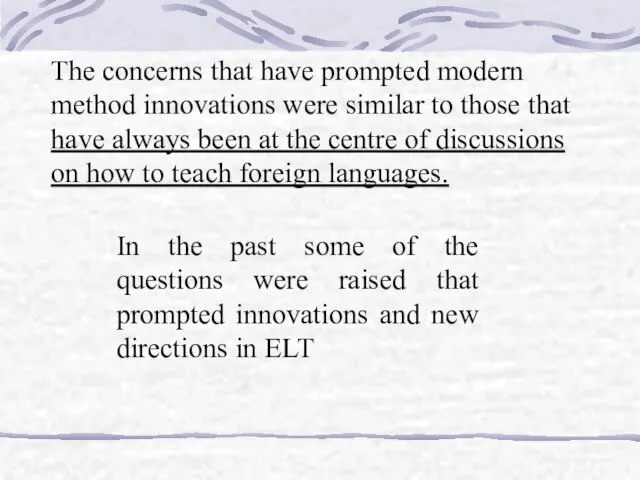

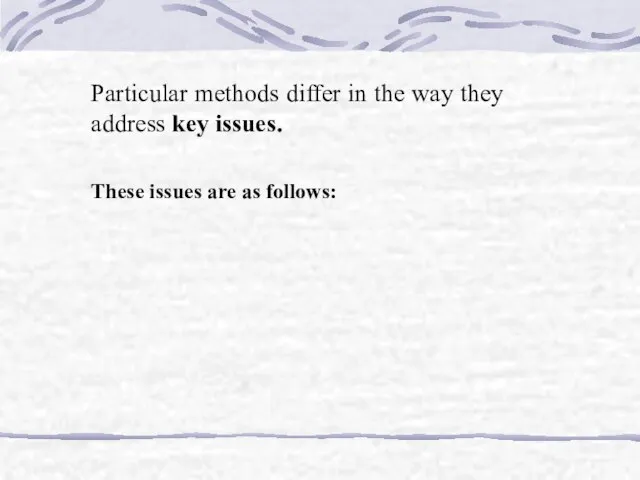
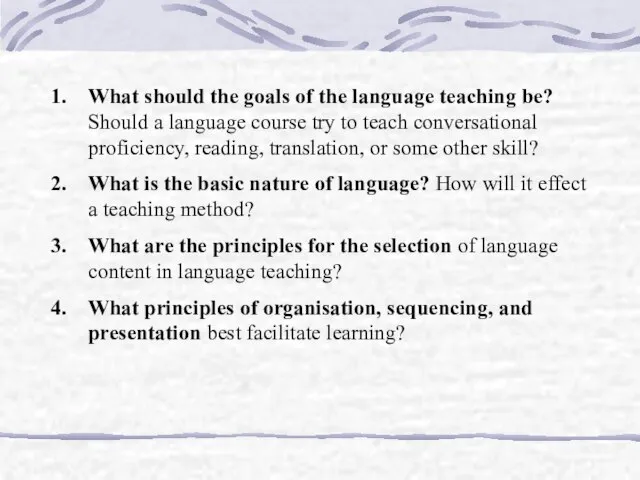
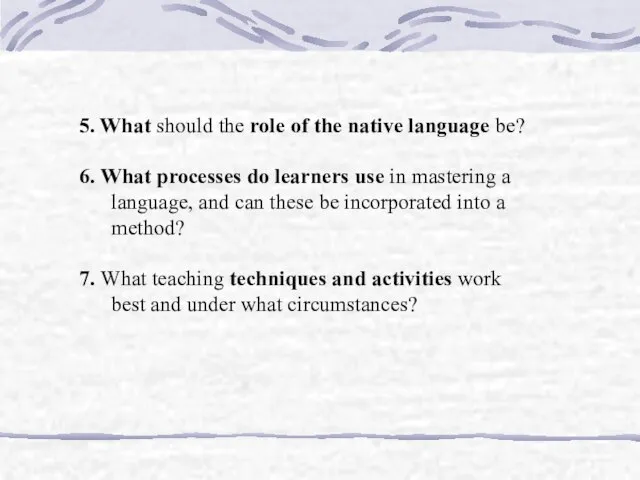
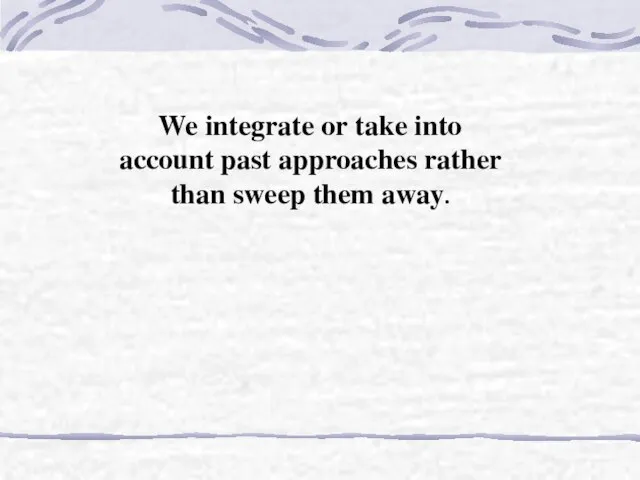
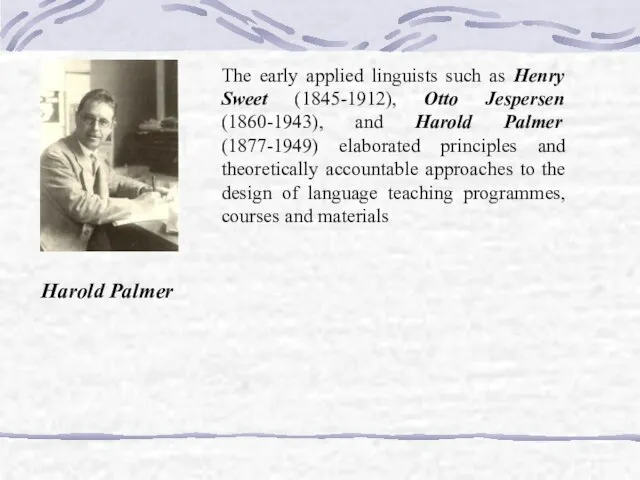
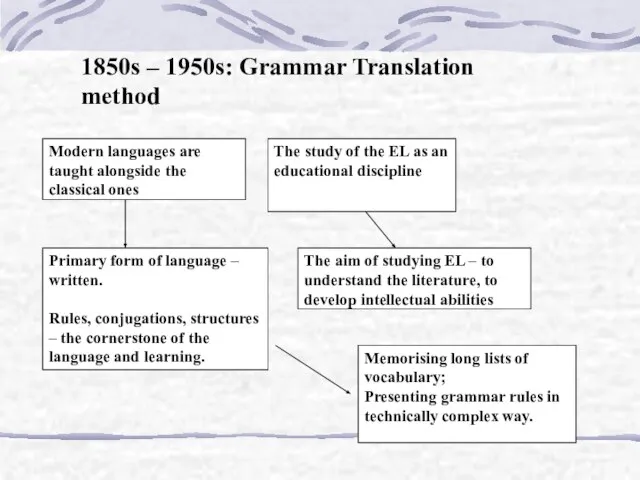
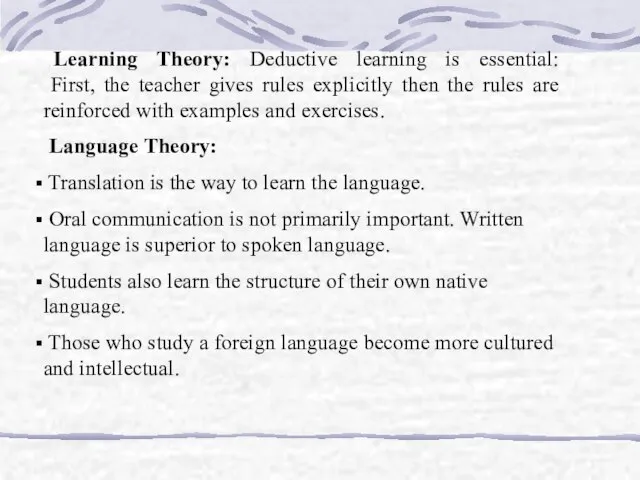
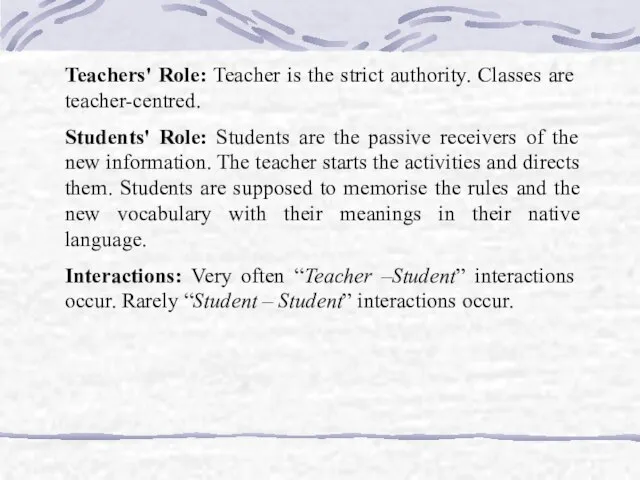

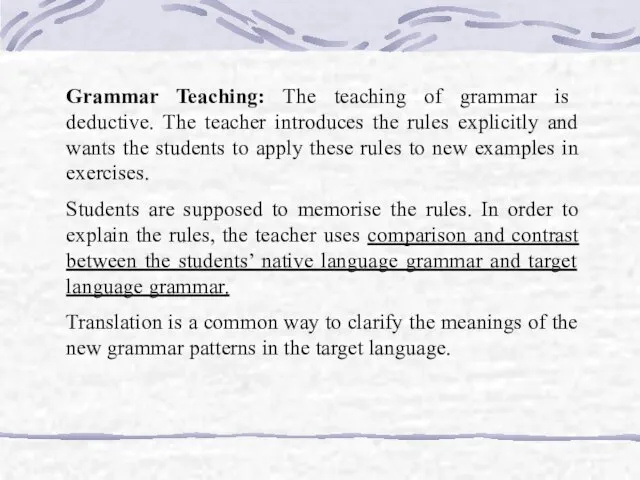
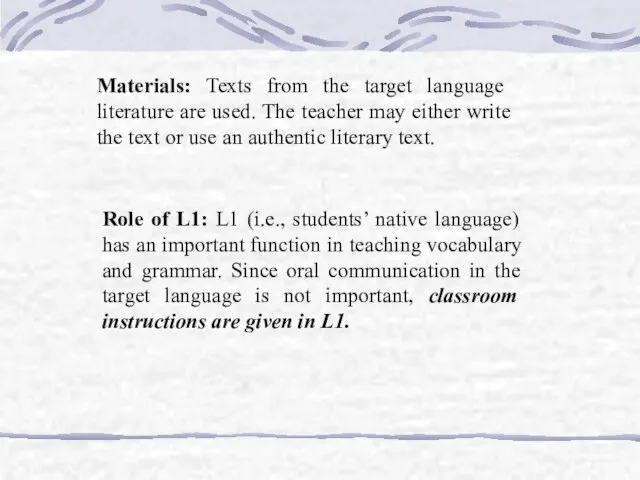
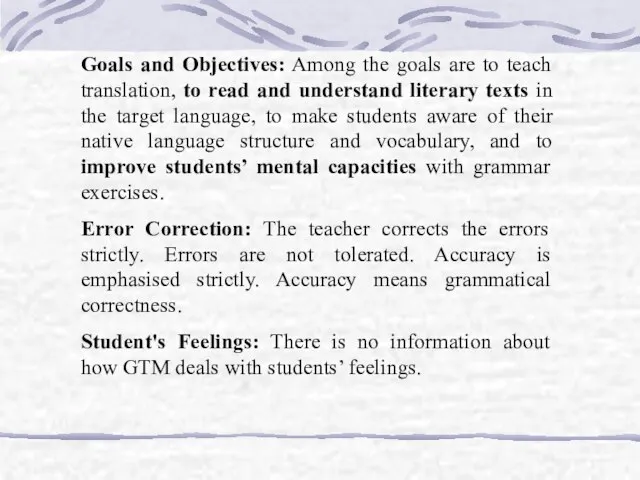
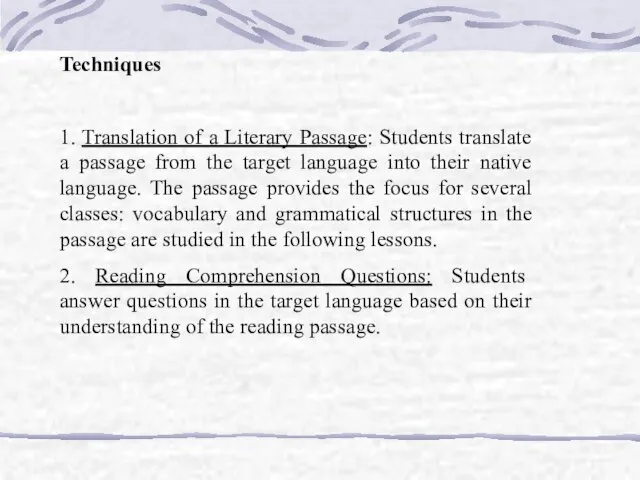
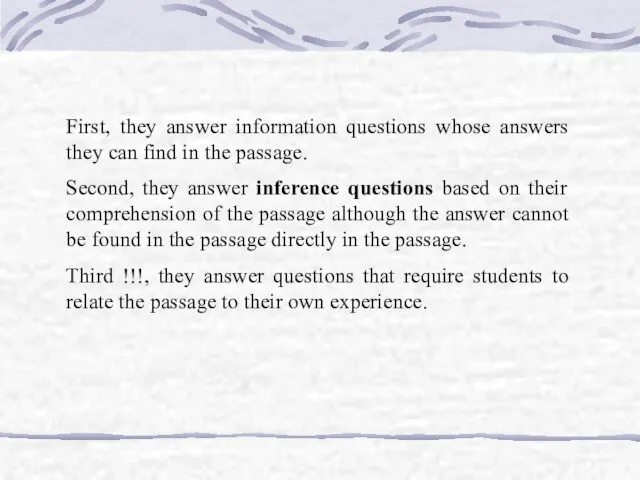

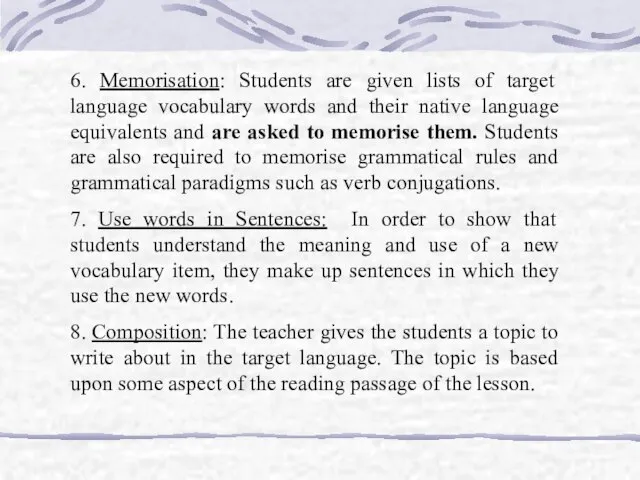
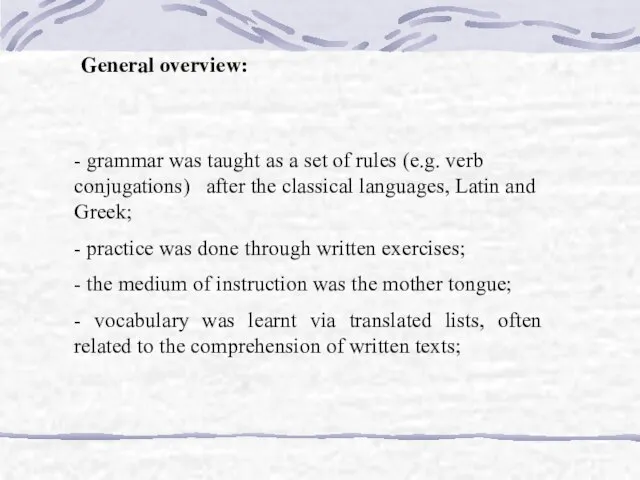

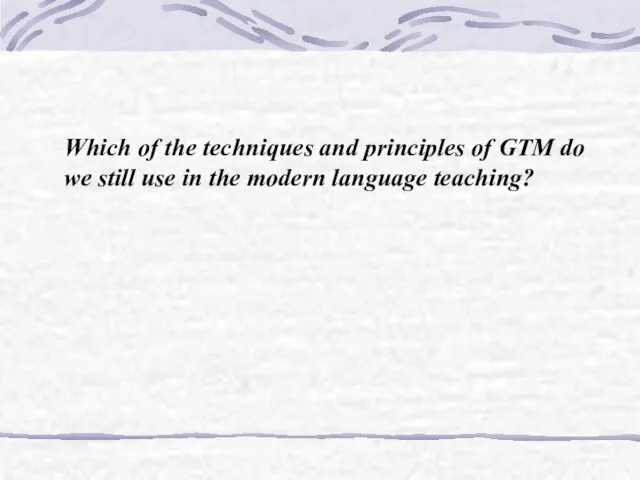

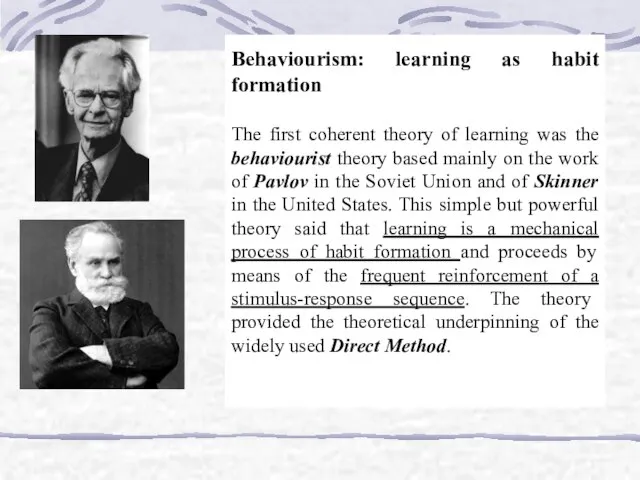
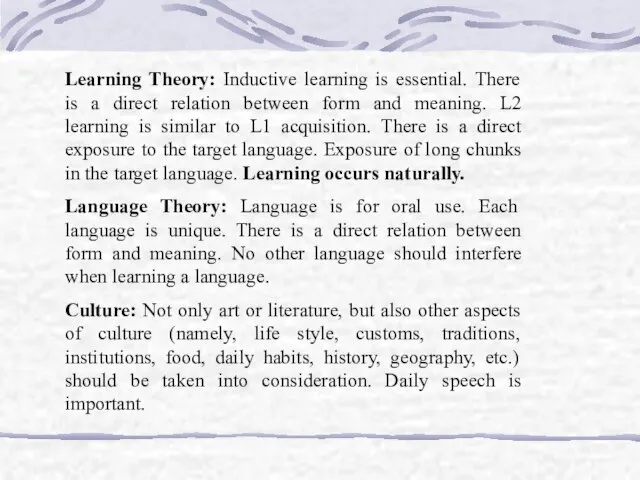
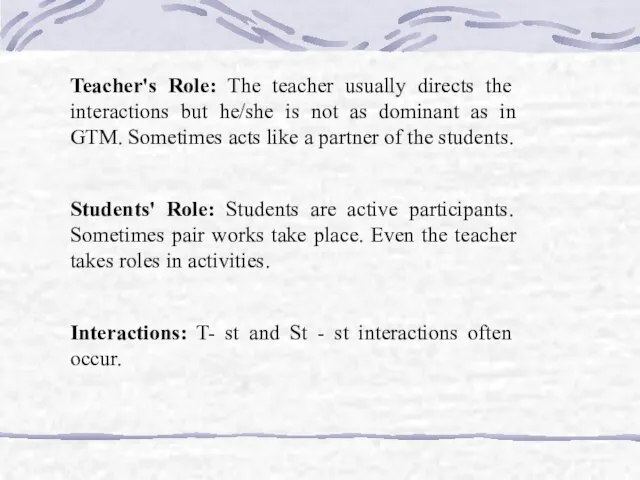
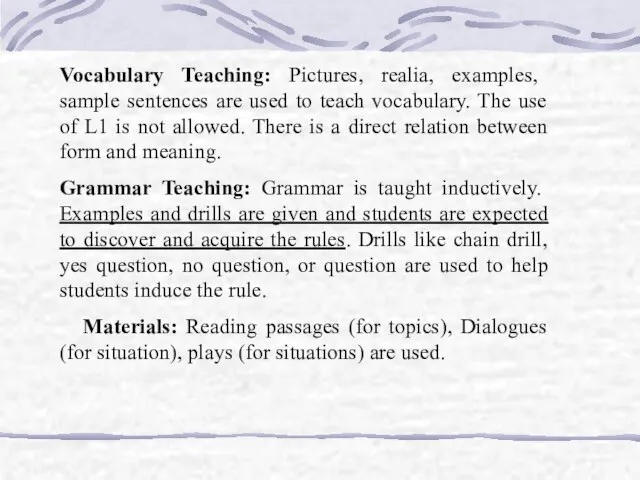
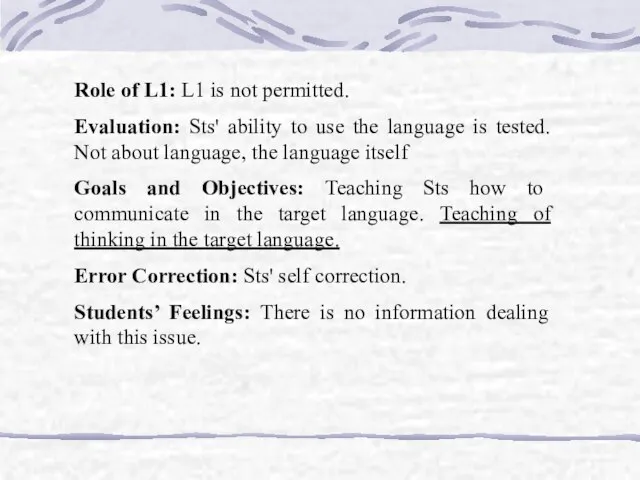
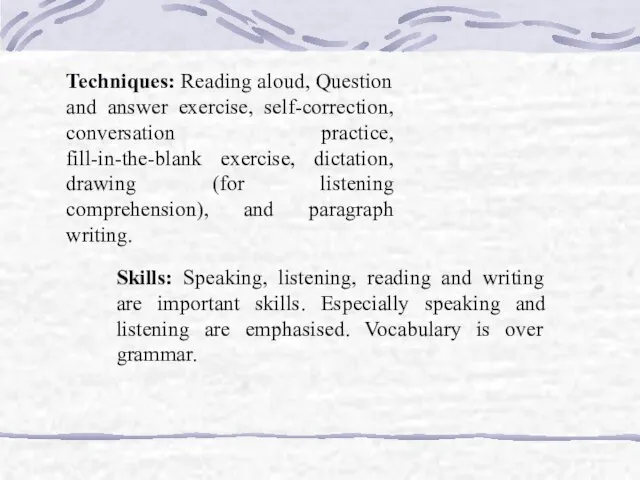
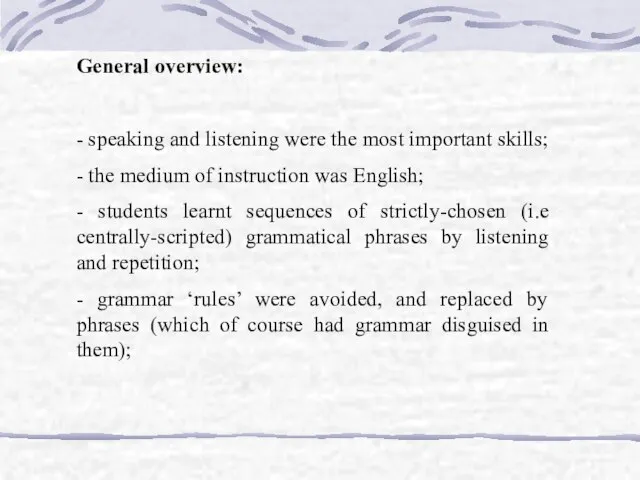
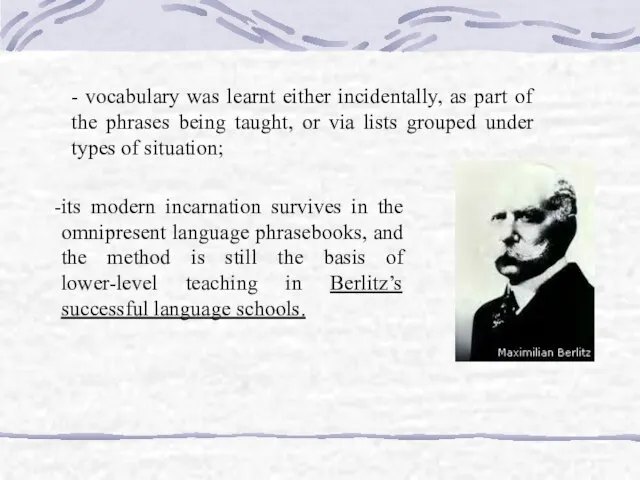
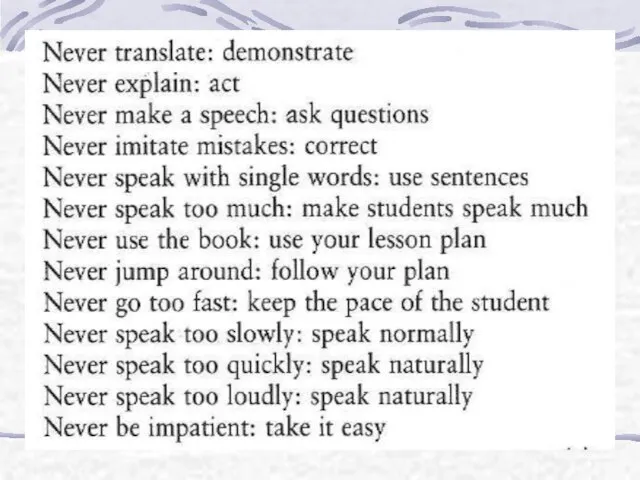

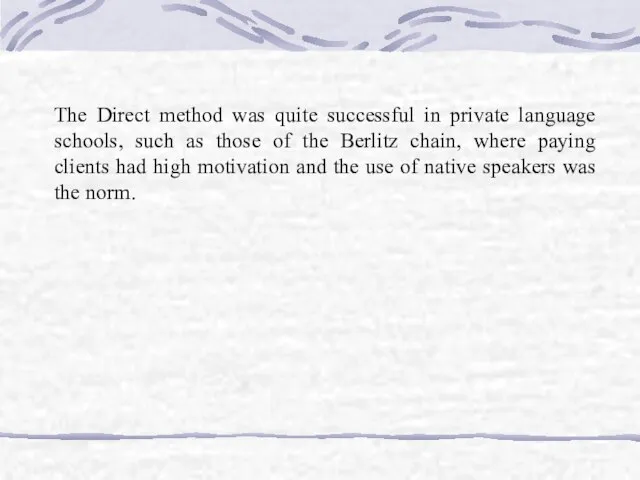
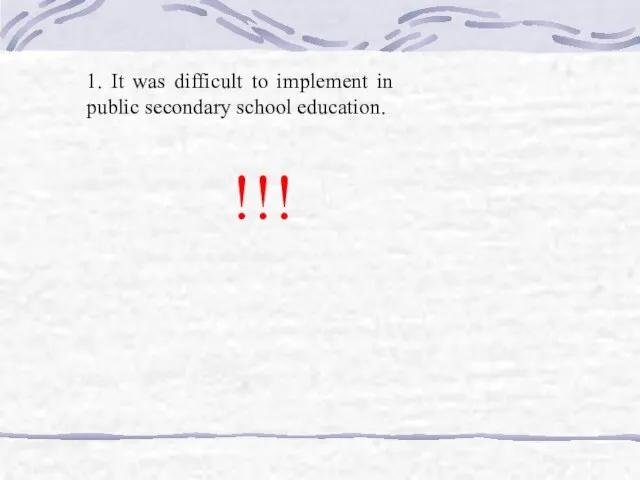
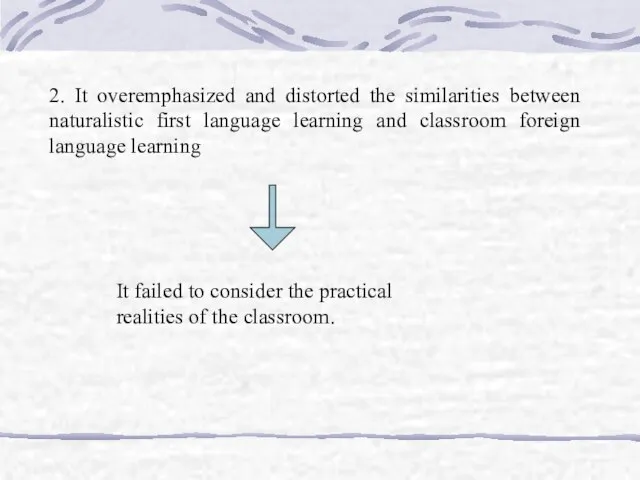
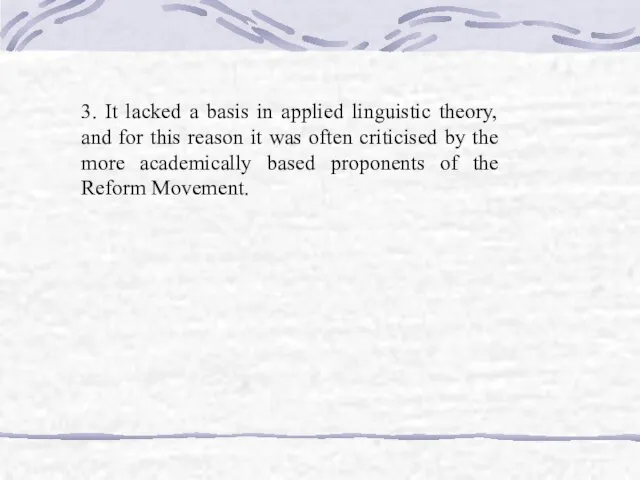
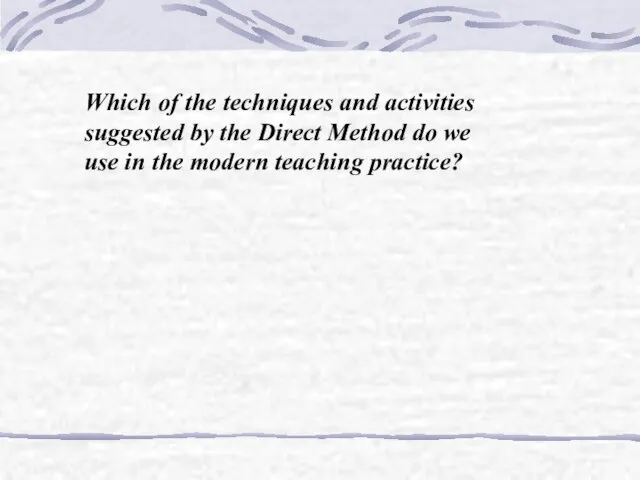

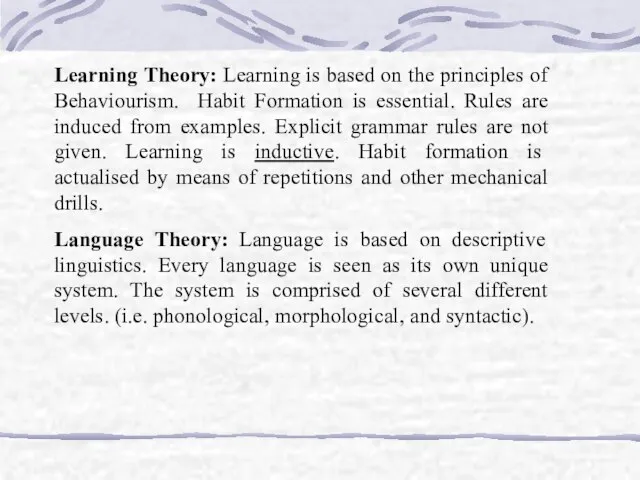

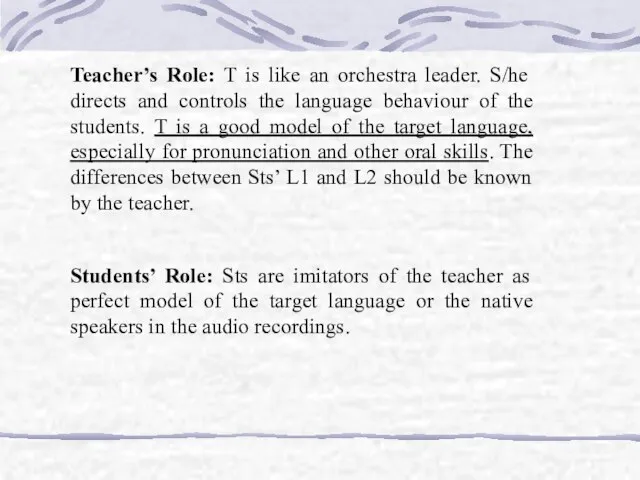



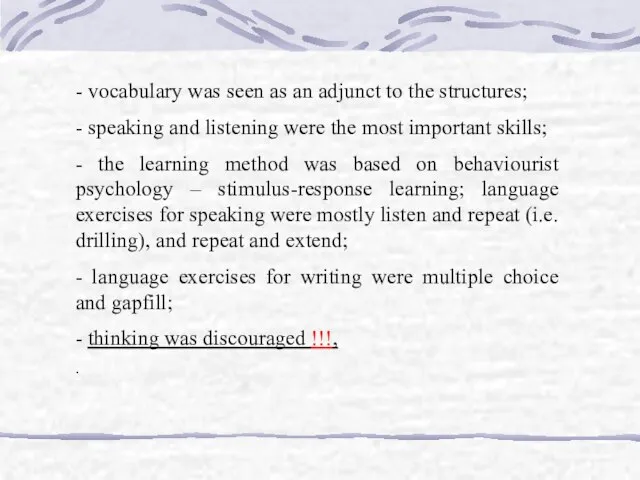
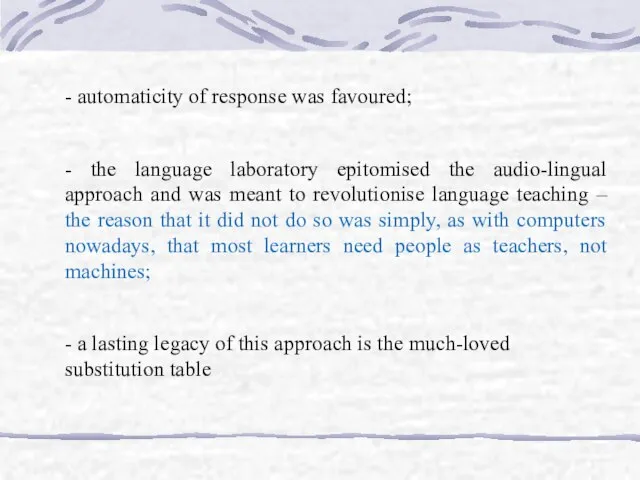

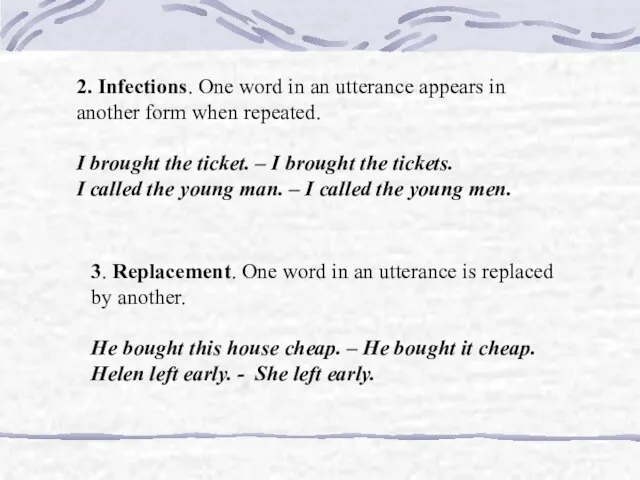
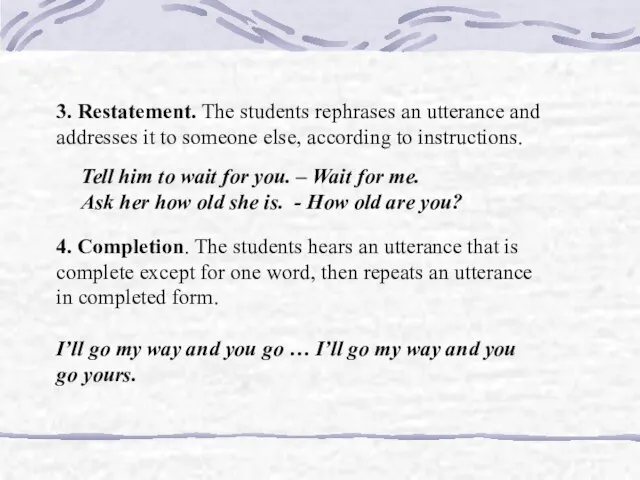

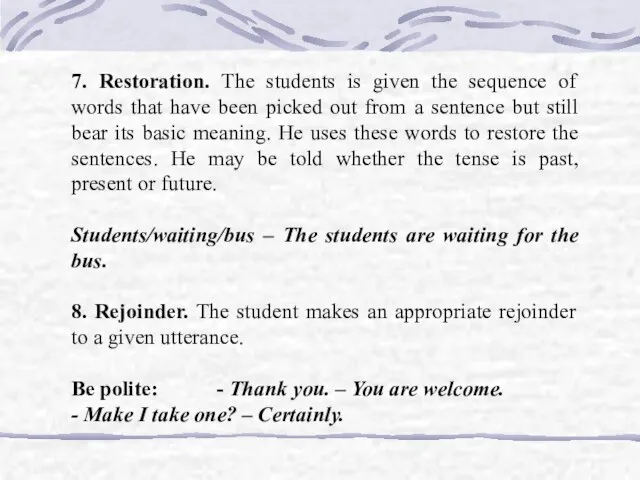
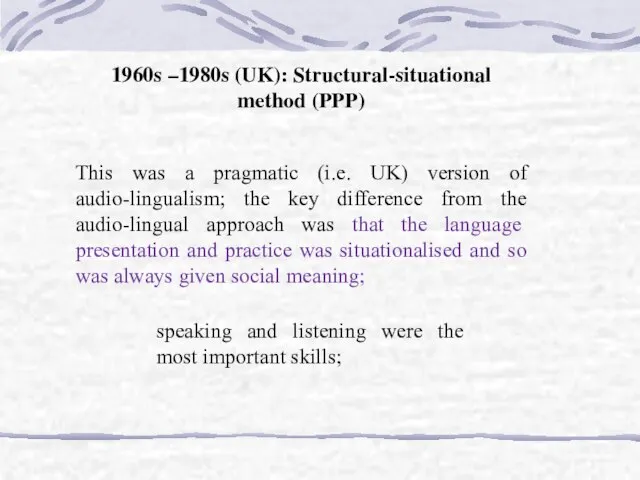
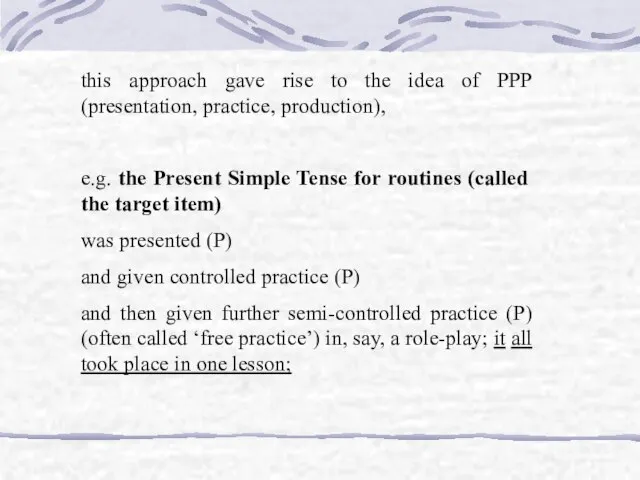
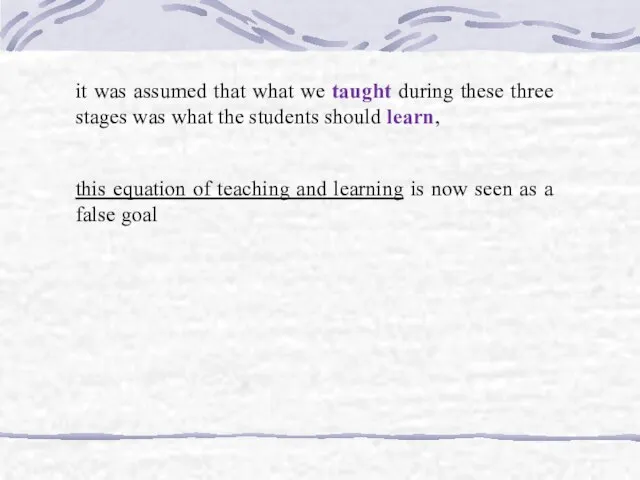
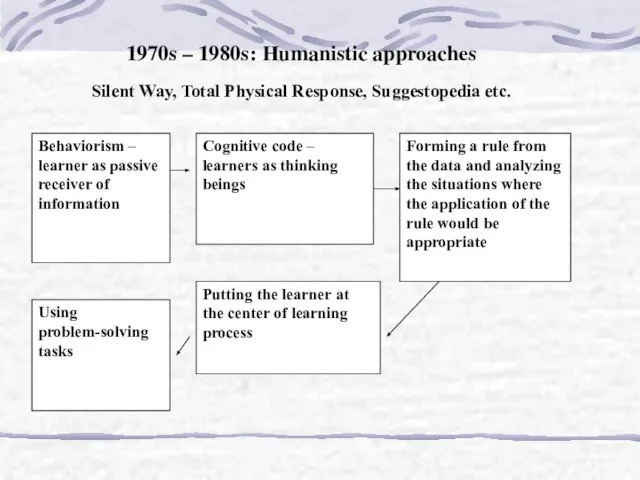
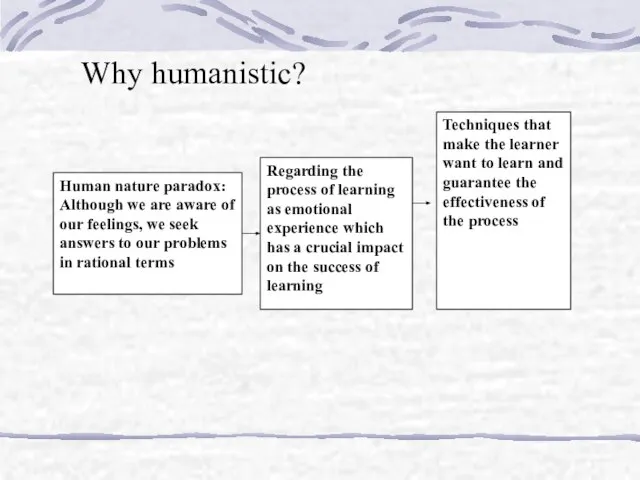
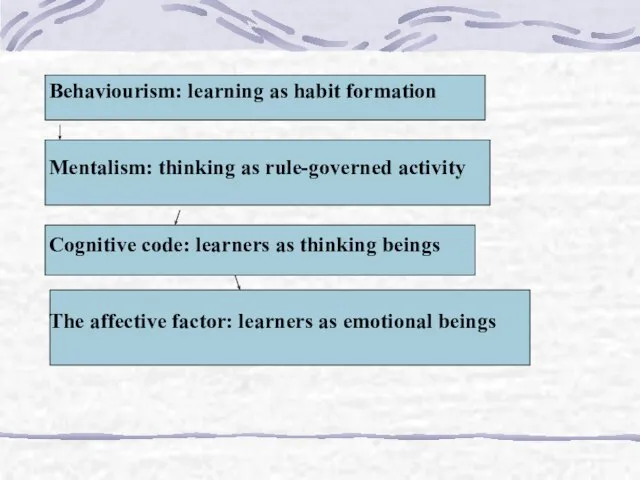
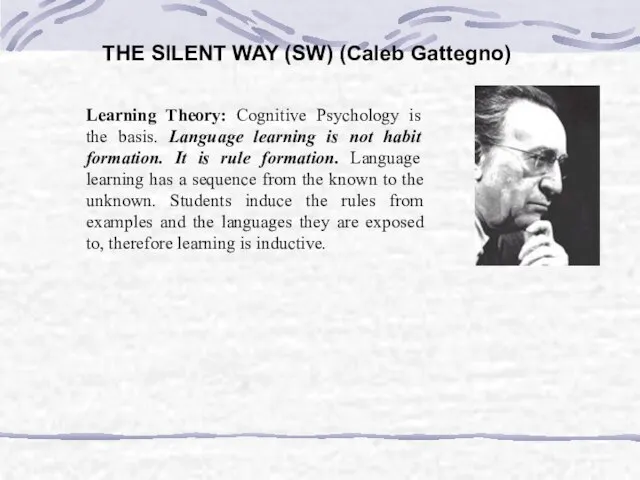
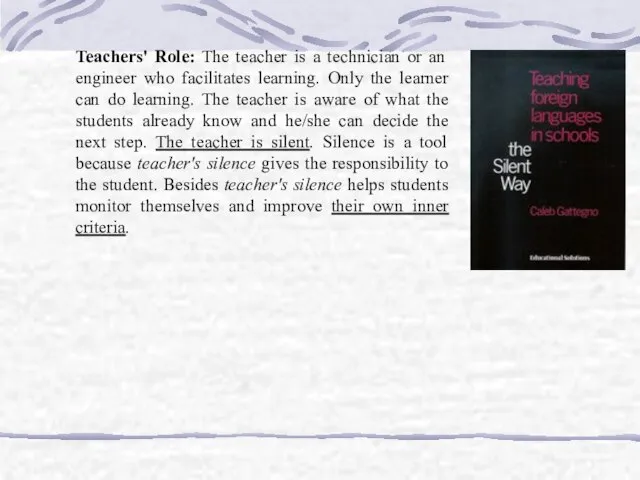
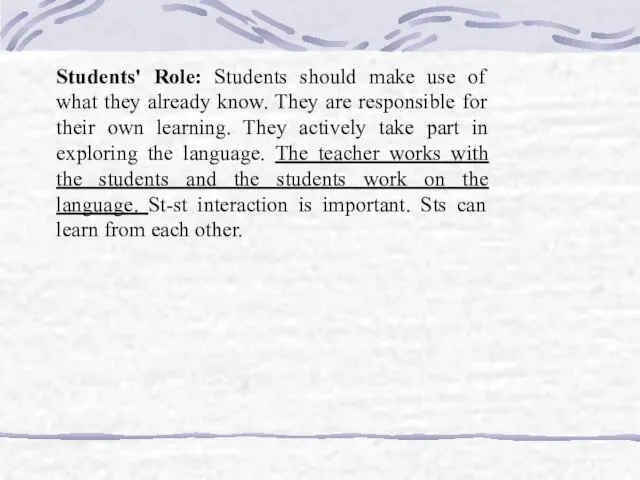

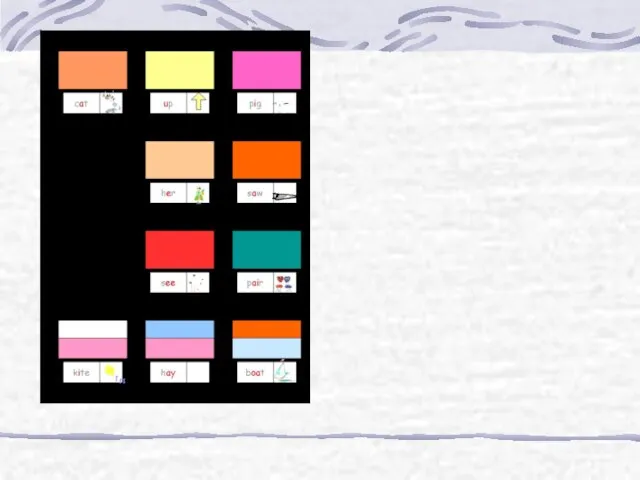

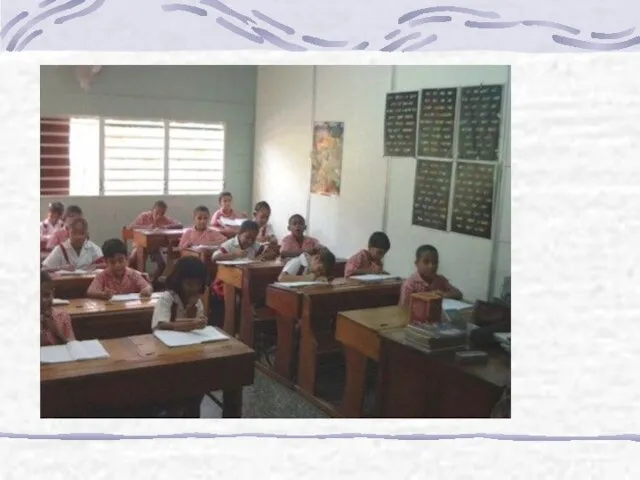
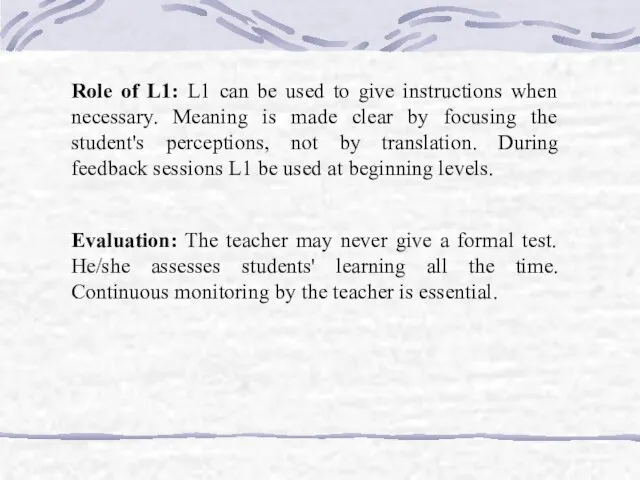
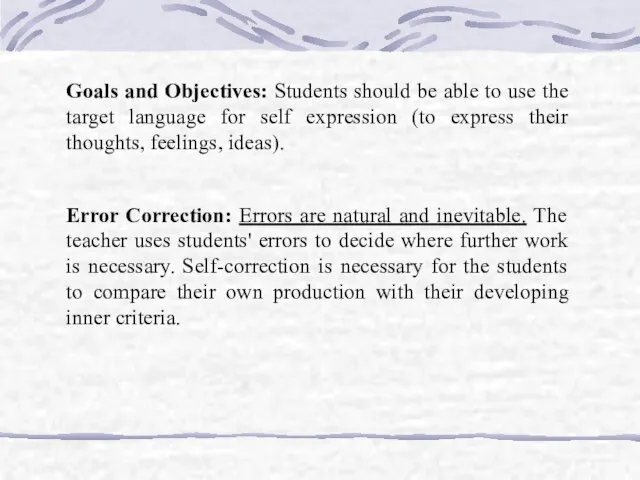

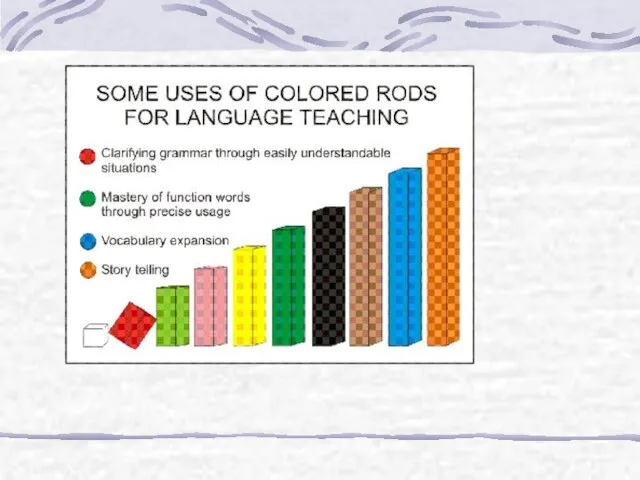
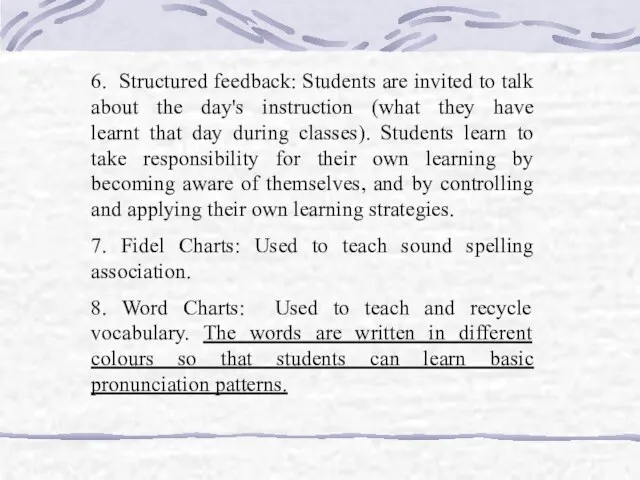
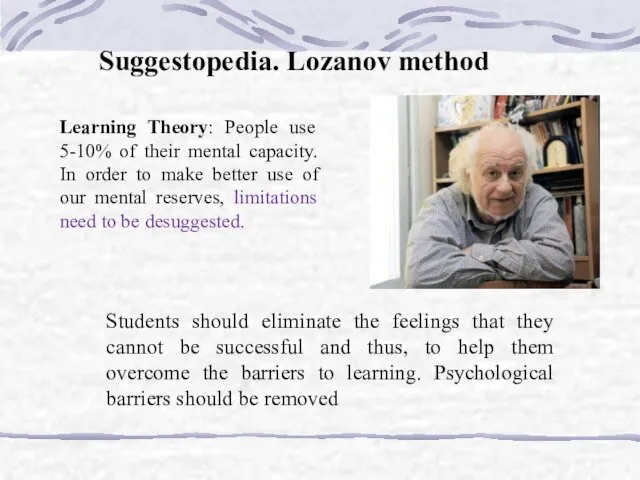
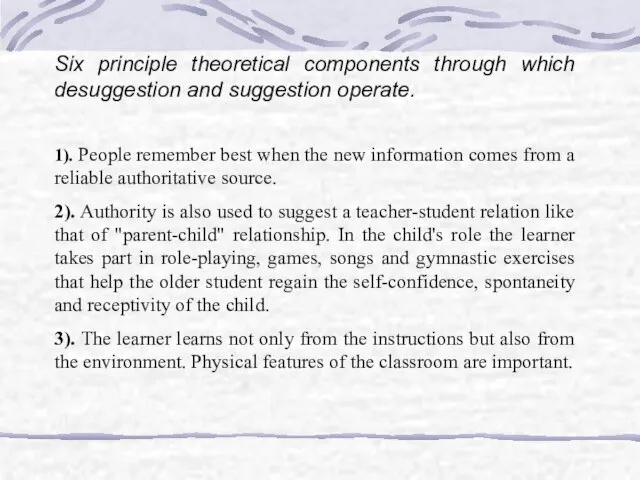
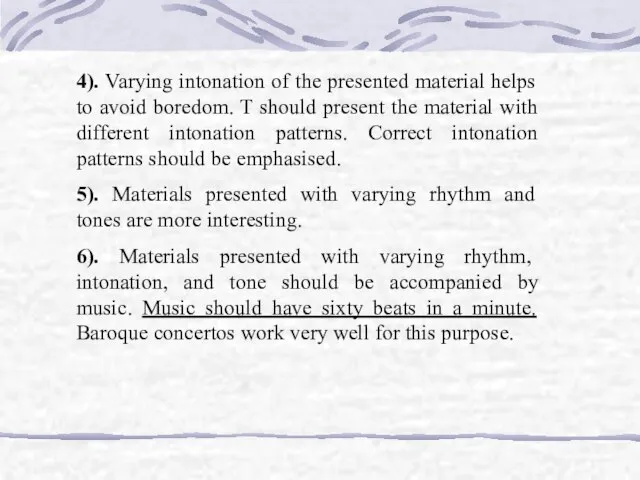
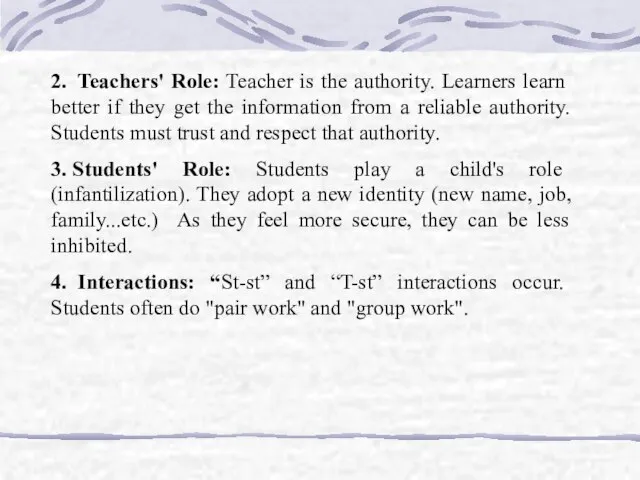
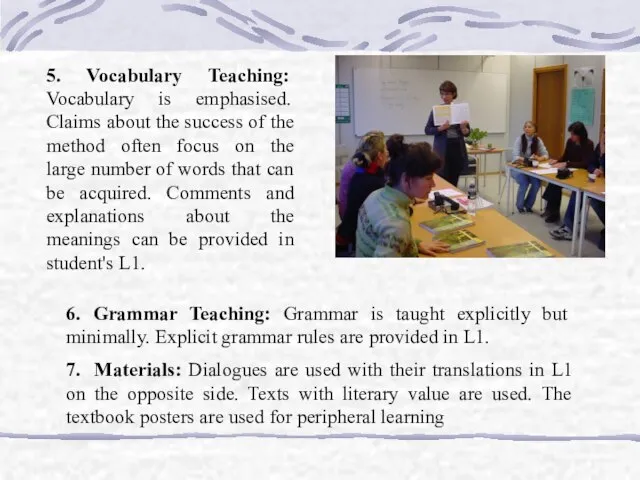
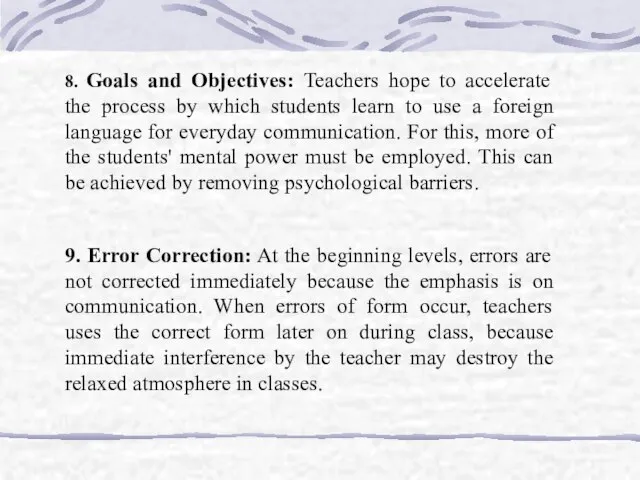

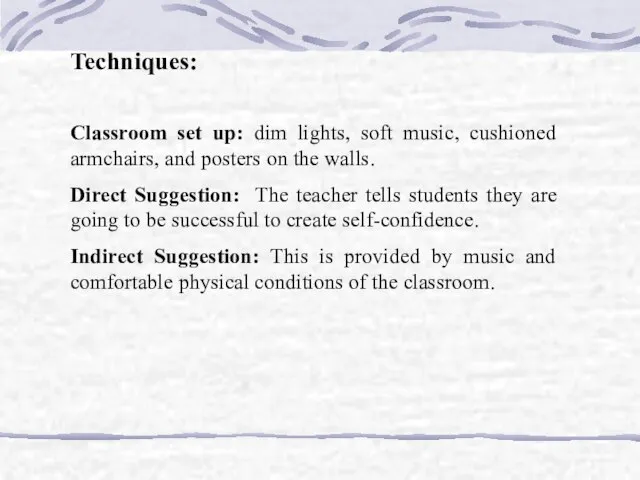
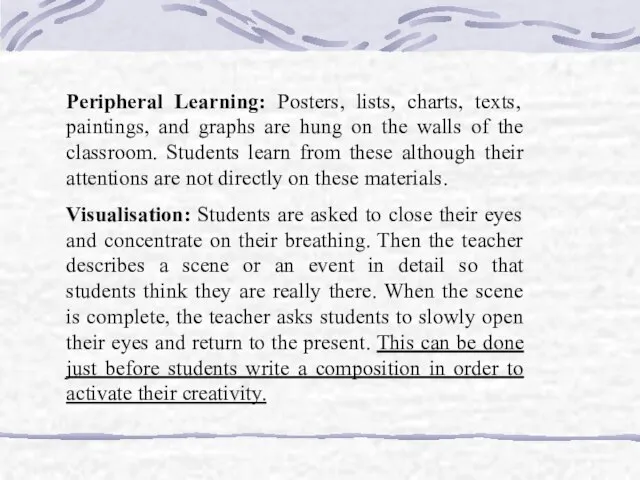
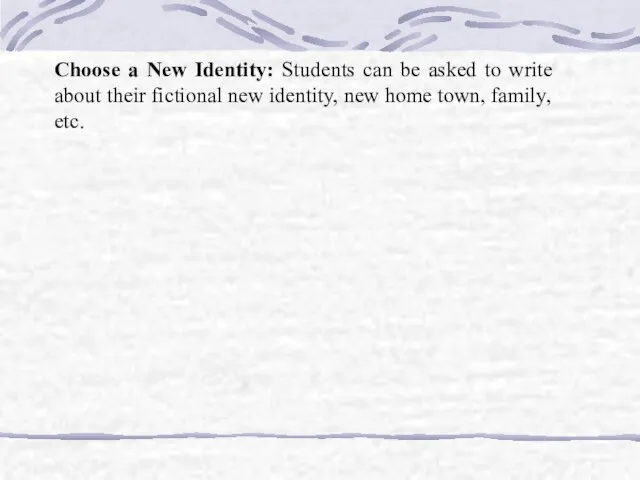
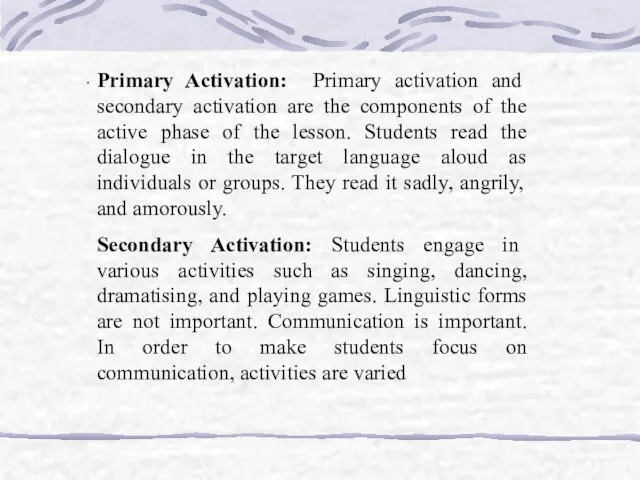
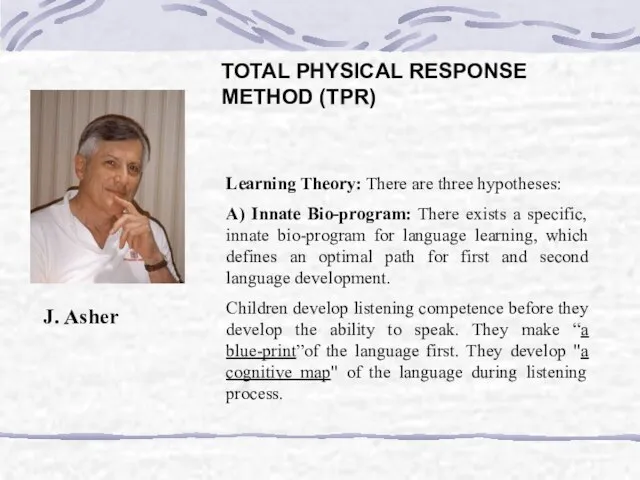
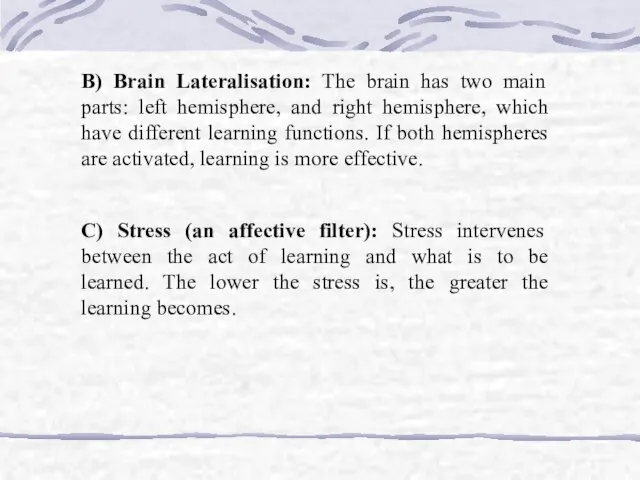
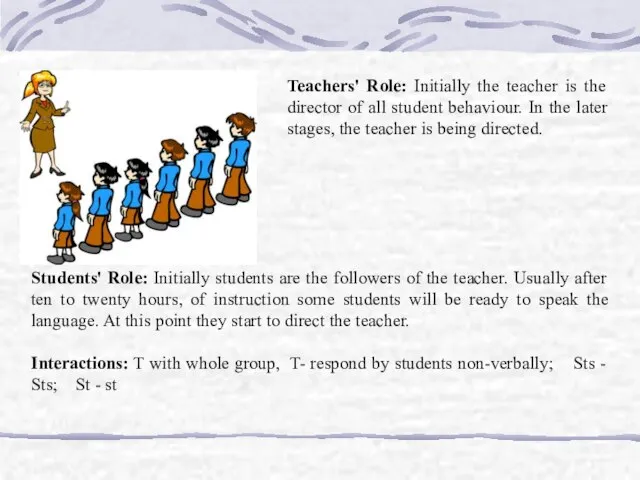
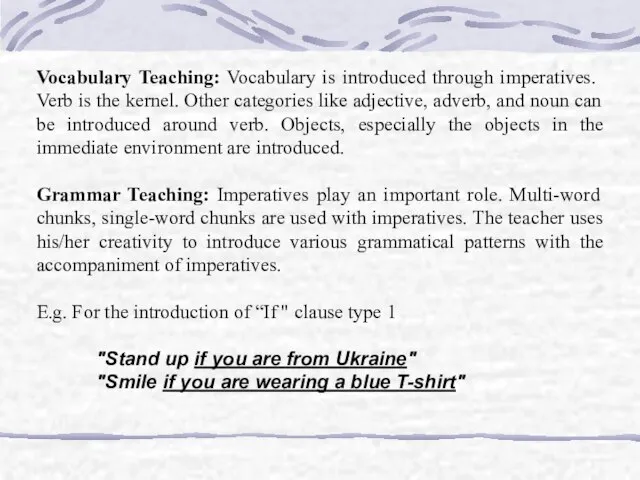

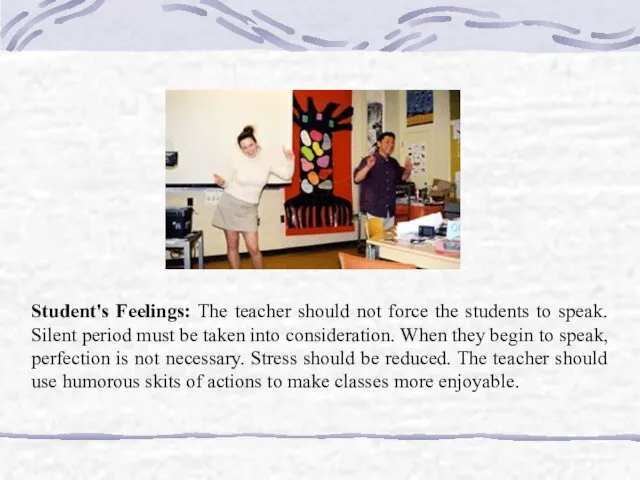

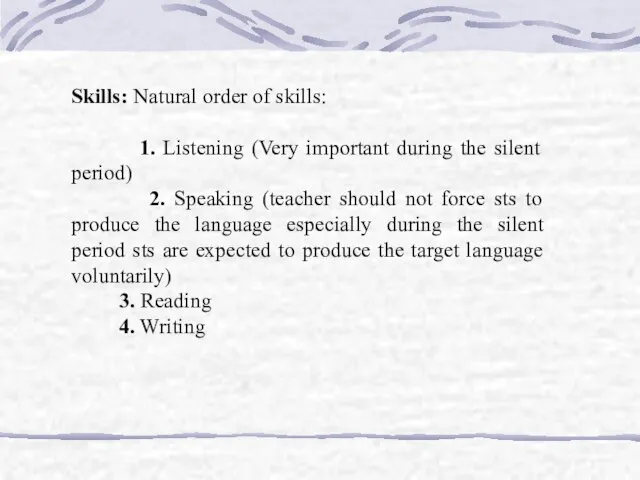

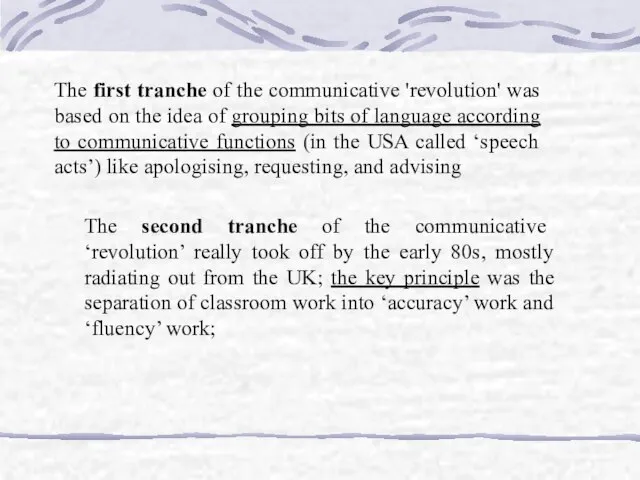

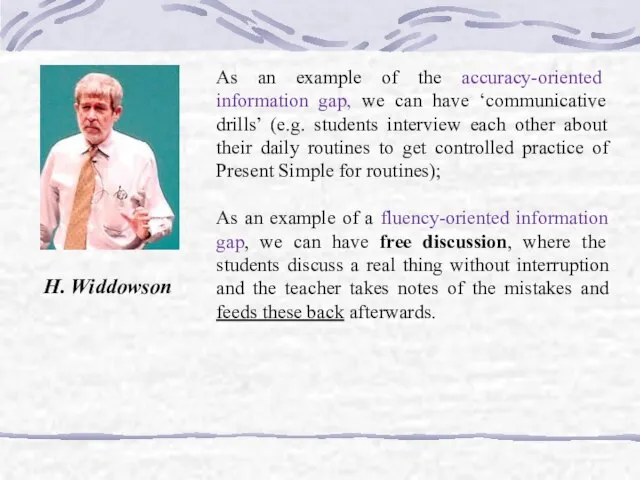
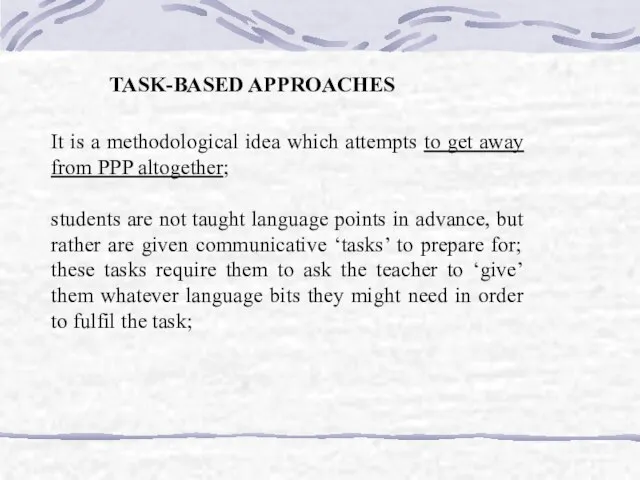
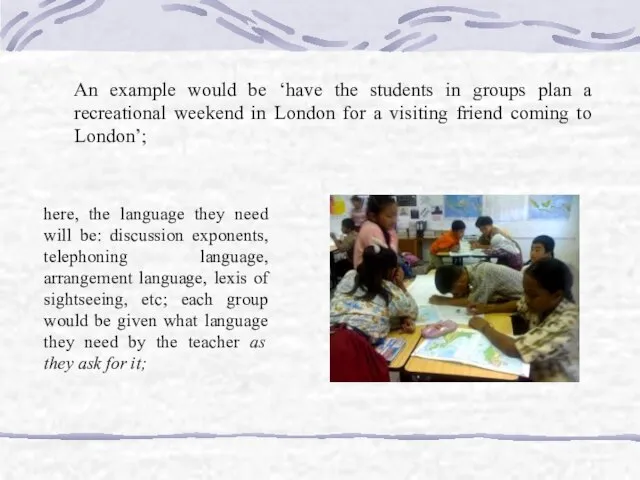
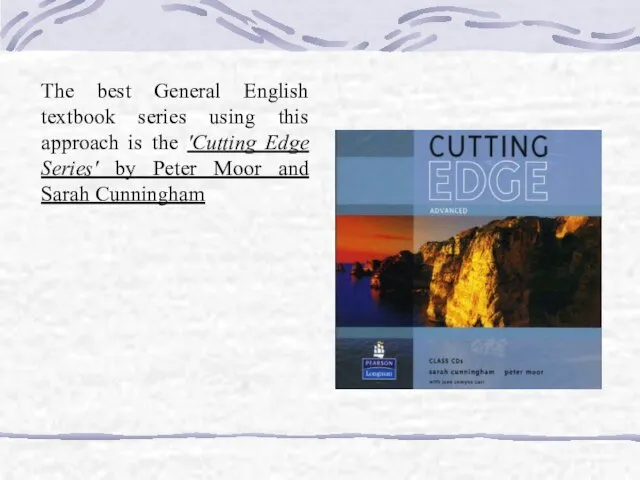


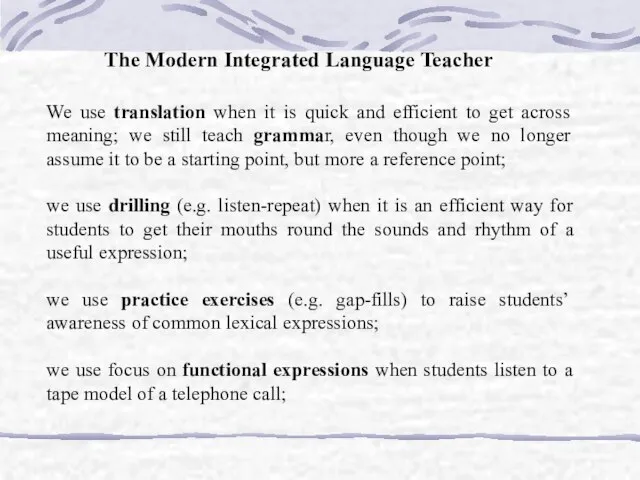

 Традиционные системы управления затратами
Традиционные системы управления затратами Презентация на тему Обмен белков,жиров и углеводов
Презентация на тему Обмен белков,жиров и углеводов  Банковская система
Банковская система Ситуация по ОСАГО
Ситуация по ОСАГО Нормативно-правовое обеспечение воспитательной деятельности
Нормативно-правовое обеспечение воспитательной деятельности Грамматическая омонимия
Грамматическая омонимия Жизнь детей по картинам XIX века
Жизнь детей по картинам XIX века Исследовательская работа по истории: Симферополь кинематографический
Исследовательская работа по истории: Симферополь кинематографический Пекарня Буханка
Пекарня Буханка Тема урока: Белки. Строение и свойства
Тема урока: Белки. Строение и свойства Кто такие и зачем нужны Попечительские советы в НКО
Кто такие и зачем нужны Попечительские советы в НКО Приглашаем вас в наш конный клуб
Приглашаем вас в наш конный клуб Парус Königsberg
Парус Königsberg Прозвенел звонок.Начинается урок .Наши ушки на макушке,Глазки широко раскрыты .Слушаем ,запоминаемНи минуты не теряем!
Прозвенел звонок.Начинается урок .Наши ушки на макушке,Глазки широко раскрыты .Слушаем ,запоминаемНи минуты не теряем! ИНТЕГРИРОВАННЫЙ УРОКФИЗИКА-ОБЖ
ИНТЕГРИРОВАННЫЙ УРОКФИЗИКА-ОБЖ ПензГТУ. Очная форма обучения места за счет бюджетных ассигнований федерального бюджета
ПензГТУ. Очная форма обучения места за счет бюджетных ассигнований федерального бюджета Эффективность бюджетно-налоговой и кредитно-денежной политик в зависимости от параметров модели IS - LM Эффективность любой поли
Эффективность бюджетно-налоговой и кредитно-денежной политик в зависимости от параметров модели IS - LM Эффективность любой поли Виды автогородков. Направления деятельности при использовании автогородков
Виды автогородков. Направления деятельности при использовании автогородков Опыт ТПУ в разработке и эксплуатации виртуальных лабораторных работ и компьютерных тренажёров
Опыт ТПУ в разработке и эксплуатации виртуальных лабораторных работ и компьютерных тренажёров Человек в зеркале искусства: жанр портрета 8 класс
Человек в зеркале искусства: жанр портрета 8 класс Слово – имя собственное
Слово – имя собственное Ежегодный проект Chef Trend
Ежегодный проект Chef Trend Обязанность по уплате таможенных пошлин при прибытии товаров на таможенную территорию Таможенного Союза Подготовили: студентки 3
Обязанность по уплате таможенных пошлин при прибытии товаров на таможенную территорию Таможенного Союза Подготовили: студентки 3 Пермский государственный технический университет Система дистанционного обучения. Организация, методология и анализ опыта
Пермский государственный технический университет Система дистанционного обучения. Организация, методология и анализ опыта Презентация на тему Состав и экономический потенциал металлургического и химико-лесного комплекса
Презентация на тему Состав и экономический потенциал металлургического и химико-лесного комплекса  Презентация на тему Центральная и осевая симметрии в природе
Презентация на тему Центральная и осевая симметрии в природе Общественно опасные деяния, посягающие на нормальное функционирование судебной системы РФ (Дипломная работа)
Общественно опасные деяния, посягающие на нормальное функционирование судебной системы РФ (Дипломная работа) Высказывания о пророке Мухаммада
Высказывания о пророке Мухаммада